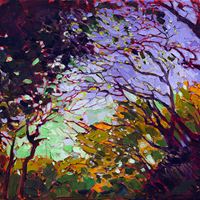

As in Olympia, the naked woman is also gazing directly at the viewer suggesting her unapologetic nature and comfort with her body being exposed to nature and the eyes of the viewer.Īmong Édouard Manet’s many “scandalous” paintings presented for the Salon, Olympia (1863) was particularly disgraceful for the 19th-century art critic since the woman portrayed is said to promote an unashamed demonstration of sexuality and pride, which you can imagine, was a complete desecration of a female nude. The presence of a female nude in this scene makes the painting contemporary and almost tends toward the first representations of modernity. Le Dejeuner sur l’Herbe (1863) by Édouard Manet, located in the Musée d’Orsay in Paris, France Édouard Manet, Public domain, via Wikimedia Commons Le Déjeuner sur l’Herbe depicts a picnic scene with a naked woman in the company of two fully clothed men.
PAINT IMPRESSIONIST STYLE FULL
While many critics commented on his painting as being too vulgar, the painting was received well by artists such as Émile Zola who said “It is…a vast assemblage, full of atmosphere, a corner of nature represented with admirable simplicity”. Édouard Manet brought much shock to the Salon after presenting the famous Le Déjeuner sur l’Herbe (“ Luncheon on the Grass”) in 1863, before his next best painting, Olympia (1863). Le Dejeuner sur l’Herbe (1863) by Édouard Manet Artist Below, we will take a look at the top 16 most famous paintings from the Impressional art period in art history, starting with a few early pieces that caught the attention of these conservative critics. Towards the later stages of the group’s operations, many artists chose to pursue their unique styles and preferences to advance their careers and this marked the birth of an individualistic approach to art and the development of different art styles, all that can now be admired and accepted as compared to the 19-century art critics who often referred to Impressionist paintings as grotesque, vulgar, and unfinished. Although the rise of Impressionism had a great start in France, it did have its influence across the world and can be seen in the works of British artists such as Wilson Steer and Walter Sickert. The group eventually formed its society and hosted a total of eight Impressionist exhibitions. The group of artists who rejected the traditional preferences were known as the Impressionists and included artists such as Camille Pissarro, Claude Monet, Edgar Degas, Mary Cassatt, Alfred Sisley, and many others. Impressionism later expanded when each member of the group (and others influenced by the original style) chose to diverge away from the idea of classification and explore their styles, which paved the way for other art movements such as Fauvism, Cubism, Neo-Impressionism, post-Impressionism, and Modernism. Impressionist art first relied on the depiction of color about light in a way that would capture the scene as it appeared to the artist’s subjective account. The Frog Pond (1869) by Pierre-Auguste Renoir, located in the National Museum in Stockholm, Sweden Pierre-Auguste Renoir, Public domain, via Wikimedia Commons One can say that everyday life was romanticized by Impressionism. On the other hand, Impressionist art revolved around landscapes, contemporary subject matter, visible brush strokes, and other scenes expressing pleasure, entertainment, and in-between moments of daily life. The ideals of the academy revolved around the representation of real-world, historical, religious, and mythological subjects in a realistic and technically correct manner (proportion, color, and subject matter). The most famous Impressionist paintings are also the first few Impressional artworks that caused quite the scandal back in the day for the reserved art critic and Salon jury member. Impressionism has its roots in mid-19th-century Paris and emerged as a result of dissatisfied artists who rejected the ideals of the academy.



 0 kommentar(er)
0 kommentar(er)
